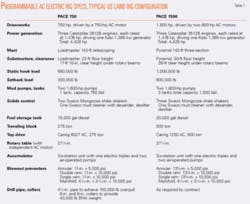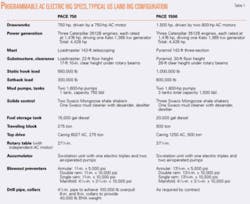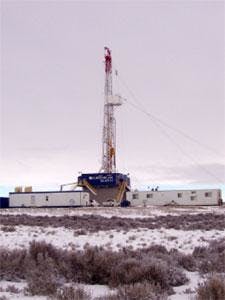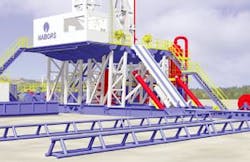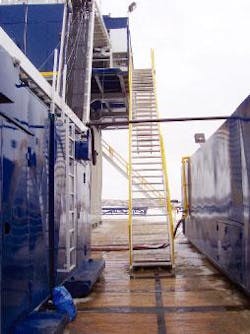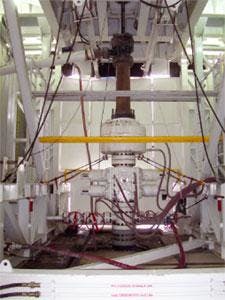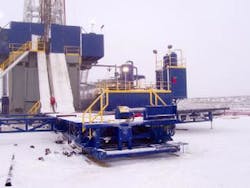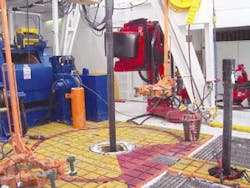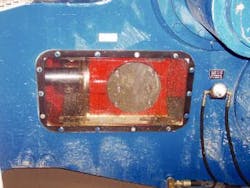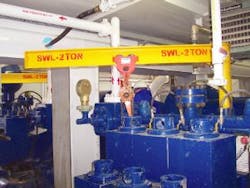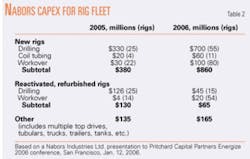Nabors Drilling designs new AC rigs
Nabors Drilling is introducing a new series of programmable AC electric (PACE) rigs. The rigs are being built in North America, the Middle East, and in China, and moving into many markets.
The PACE 750 and PACE 1000/1500 designs have slightly different specifications although Nabors is keen to standardize components to improve economies of scale and increase fungibility of components and drill crews (Table 1).
Nabors says that AC power provides more accurate control of speed and torque than direct current. AC electrical systems also require less maintenance and facilitate online diagnostic checks of equipment and systems. AC-powered drilling rigs have fewer electrical connections and better motor efficiency and produce less noise and fewer emissions, enjoy better power distribution, says the company. Nabors has been working with AC top drives for more than a decade.
The PACE rigs incorporate programmable logic controllers (PLC), which the company says allow the driller to control the drawworks, top drive, pipe-handling equipment, mud pumps, and many other systems from a central control center and remote locations. PLC facilitates integrated systems for anticollision, over pull limits, and automated alarms. The heart of the PLC system is the variable frequency drive (VFD) room, containing circuitry for the entire rig. The VFD replaces the SCR room on DC-powered rigs.
The Canadian-built PACE rigs contain two synchronous generators from WEG Industrias SA in Macquinas, Jaragua do Sul, Santa Catarina, Brazil.
HSE
The design also incorporates a variety of safety features and fuel-efficient systems, Nabors says.
Safety equipment includes Varco ST-80 iron roughnecks on the drill floor to make and break connections; automated catwalks and pipe-handling equipment; remotely operated cameras in the derrick; and in some cases, air-powered slips.
Environmentally friendly additions include upgraded fluid containment systems; the use of “lubsters” to distribute different lubricants; and new, efficient Caterpillar engines (CAT 3512 series).
Ron Witherspoon, manager of Nabor’s rig operations in the central US, told OGJ that customers want rigs incorporating the latest technologies and automation, and the PACE rigs are designed to fulfill that, he said; “They are compact, easy to rig up and down, fast moving, and produce less environmental impact.” Two new PACE rigs built in Canada are currently at work in the US (Fig. 1). These rigs have a slingshot substructure that allows them to fold for moving on roads.
The new rigs have small footprints relative to older rigs. The drawworks is mounted on the substructure, which allows the rig to be fitted with an optional lift and roll skidding system for pad drilling (Fig. 2). Rig 784 AC has drilled wells for Shell USA on the Pinedale anticline in Wyoming on 80-ft centers. The lift and roll system moved about 20 fph.
Another PACE rig is under contract to drill 32 wells on a pad 1,200 ft long and 550 ft wide at the Firebag project in northern Alberta. The rig on location has a unique system to move backwards, forwards, and sideways across the pad.
Mast, substructure, drawworks
The mast and substructure can each move in three loads without requiring a crane. The integrated Canrig top drive and traveling block remain in the mast during a move. The mast and substructure are raised hydraulically.
For added flexibility in configuration, the mast can be raised or lowered from either side of the rig, and the automated catwalk can be positioned in two different locations.
Exterior staircases do not have to be separately raised and lowered as the substructure is moved. Fig. 3 shows two staircases and wood decking at a drill site in Wyoming. The staircase in the foreground is used when the substructure is erected, and the shorter staircase behind it is used when the drill floor is lowered.
The substructure and blowout preventer (BOP) can be completely covered with wind-proof textile walls that provide a warm, comfortable working environment in the winter (Fig. 4). The giant hydraulic cylinders beneath the drill floor are separately sheathed and protected from windblown dust and grime.
The hydraulic power unit has failsafe systems that will stop operations if one of the hydraulic cylinders fails.
The BOP handling system moves the BOP in one piece, allowing a faster and safer rig-up.
Pipe handling is fully automated. The skates move pipe from the rack on the right onto the catwalk and the beaver slide moves pipe along the catwalk (Fig. 5).
PACE rigs can be equipped with Nabors’ Commander-class drawworks, which the company says are designed to be compact, operate quietly, and require little maintenance. The drawworks have a hydraulic cathead. Floor savers and crown savers reduce collisions by issuing a loud alert and shutting the system down if the top drive moves too far out of range.
Rig floor (and below)
The climate-controlled drillers’ cabin has windows on two sides as well as a wide, slanted roof window, allowing a clear view into the derrick. Windows are made of bulletproof, shatterproof glass.
The control panel is open and easily accessible, says Nabors. There are two cameras in the derrick; one on the monkey board and another about 30-ft below. They are fully rotational and can zoom. The cameras contribute to safety and efficiency, says the company, because they reduce the need for personnel to climb into the derrick to check for hydraulic leaks, among other things.
Drilling controls are operated with touch screens and joysticks. Automated troubleshooting helps the driller keep tabs on systems and avoid accidents.
The three-mode auto driller is integrated into the rig system and uses weight on bit (WOB), rate of penetration (ROP), and delta p.
The driller keeps a digital pipe tally on an EPIC system run on a Panasonic ToughBook notebook computer, as well as keeping a traditional paper tally.
Some of the systems, including the pipe-handling equipment, can be operated with a Cattron remote. This remote contains a 9-hr rechargeable battery.
The rotary table and rig floor and rig floor of a Canadian-built PACE rig were brightly painted to improve visibility and increase alertness. Note the manual slips in Fig. 6.
Nabors says it designed the mud pump upgrades with increased power to improve drilling speed and efficiency and reduce operator costs.
An interesting innovation is the addition of clear polycarbonate inspection plates on the sides of each mud pump to allow a view of the pistons (Fig. 7)
Other additions are the two jib cranes positioned over the pumps (Fig. 8).
PACE in the US
Nabors built two PACE rigs in Canada in 2005 that were sent to the US. The first arrived in Colorado in mid-2005, the second in Wyoming in December. A third PACE rig is to arrive in North Dakota in first-quarter 2006 and drill for Amerada Hess Corp. in the Williston basin, Witherspoon said. Four more Canadian-built PACE rigs will begin work for BP PLC in Wyoming later this year.
Last month, OGJ visited Nabors Drilling Rig 405 in the Green River basin outside of Wamsutter, Wyo. (Fig. 1). The rig had nearly completed drilling the 32-24 well in the Siberia Ridge field for Whiting Oil & Gas Corp.
Whiting acquired its position in Sweetwater Co. through its 2004 acquisition of Salt Lake City’s Equity Oil Co. Whiting describes Siberia Ridge as a “multiwell low risk resource play,” primarily targeting the Cretaceous Almond formation at 10,500 ft depth. The company has interest in more than 2,200 gross (1,580 net) undeveloped acres with 50-100% working interest. Whiting planned 15 wells in the Siberia Ridge field in 2005.
James J. Volker, chairman, president, and chief executive officer of Denver-based Whiting Petroleum Corp., told OGJ that the company would like to “use 60-70% of our discretionary cash flow for drilling” in 2006 and beyond (OGJ, Oct. 24, 2005, p. 28).
Under construction
Nabors needs additional capacity and said the cost of building new rigs is favorable compared to the escalating cost of upgrading and reactivating older rigs. In 2005, the company spent $380 million on new construction and $265 million on upgrades, enhancements, and refurbishments. In 2006, it will spend $860 million on new construction and $230 million on upgrades, enhancements, and refurbishments (Table 2).
According to data presented by Nabors at an analyst’s conference in January 2006, Nabors Offshore and Nabors Drilling USA are building 7 drilling rigs in 2005-06; Nabors International is building 5 drilling rigs. Nabors Canada (Academy) is building 12 drilling rigs in the same period, with options to build 8 more, and customer commitments for 11.
Nabors Industries Ltd. is building 75 PACE drilling rigs, with customer commitments for 61 of the Chinese-built rigs.
Nabors has dozens of new PACE rigs under construction at Chuanyo Guanghan HongHua Co. Ltd. (OGJ, Sept. 26, 2005, p. 39). HongHua, the second-largest rig builder in China, is based in Guanghan City, Sichuan Province, and is building almost all of the PACE rigs for Nabors, according to Denny Smith, director of corporate development at Nabors.
A few PACE rigs are being built at Baoji Oilfield Machinery Co. Ltd. BOMCO is based in Baoji, Shaanxi Province, and recently announced that with the help of China Petroleum Technologies Co. Ltd., it exported three PACE rigs for the American market. BOMCO has five more PACE rigs under construction.
Gene M. Isenberg, Nabors chairman and chief executive officer, told OGJ that the Chinese are building masts and substructures; “smart iron” systems are added after delivery in North America.
Two PACE rigs (Rig 54 and Rig 200) were assembled in the Lamprell yard in Jafza, UAE, last year. They are now both working in UAE (OGJ, Feb. 13, 2006, p. 45).
Nabors maintains three training centers in the US: Casper, Wyo.; Houma, La.; and Oklahoma City. In addition to actual drilling and workover rigs, these facilities include derrickman simulators, driller AC training centers, and drilling simulators. The company says that training on simulators keeps its workers safer and saves its customers from unnecessary downtime in the field.
Nabors Drilling USA says that it has 11 rigs that have never had a recordable injury since they were built and 112 rigs without a lost-time incident since they were built.
The new state-of-the-art PACE rig designs, coupled with comprehensive training, are key in attracting and retaining employees, Witherspoon said. Crews will be working on more reliable rigs. Operators will save on fuel costs and reduced downtime.
In a presentation to analysts in December 2005, Nabors said that it had new US drilling commitments for 29 PACE rigs in the 750-1,000-hp range and 18 PACE rigs in the 1,500-2,000-hp range. Additionally, the company saw a high potential for 18 more of the lighter rigs and 19 more of the heavier rigs in 2006.
In first-quarter 2006, Nabors expects to have 457 rigs drilling worldwide and 600 workover/service rigs in North America. ✦
